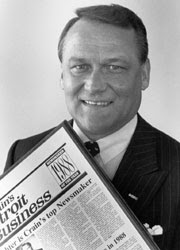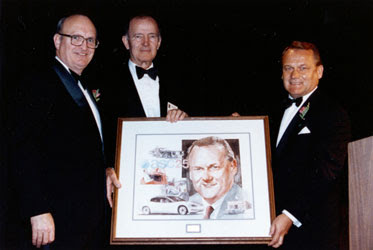Start Small & Dream Big - The American Sunroof Corporation Story: Part 2
At the dawn of the 1980's, American manufacturers were downsizing, and so was American Sunroof Corporation. Competition from foreign automakers, specifically the Japanese, were driving the "big three" to be leaner, meaner corporations. Sales of new models were down, and as a result the ASC workforce was scaled back to keep the company solvent. It was a hard decision, but faced with a lack of consumer demand, Heinz Precther had no choice but to cut staff from more than 2,000 employees to roughly 500 in 1979. In spite of the economy, Prechter received recognition for his work that year from the Havard Business Club.
 | ||
| Heinz Prechter, Harvard Business Club's Entrepreneur of the Year for 1979 |
 Before the 1980's, Prechter's company American Sunroof Corporation had specialized in building low-volume specialty cars for large automotive companies. In the coming years they would do it all. After an industry-wide moratorium on convertible prodcution in the late 1970's, public demand for open-air cars began to build. During this time, General Motors executives sensed an opportunity & approached Precther's group to inquire about a limited production run of a convertible version of their freshly redesigned E-body platform. The Buick Riviera, Cadillac Eldorado, and Oldsmobile Toronado went from a Brontosaurus-sized car in 1978 to a respectable full-sized model in 1979. The Buick Riviera also went from a RWD variant of the B-body car platform, to a FWD cousin of the Eldo and Toro, cutting costs and saving valuable development time.
Before the 1980's, Prechter's company American Sunroof Corporation had specialized in building low-volume specialty cars for large automotive companies. In the coming years they would do it all. After an industry-wide moratorium on convertible prodcution in the late 1970's, public demand for open-air cars began to build. During this time, General Motors executives sensed an opportunity & approached Precther's group to inquire about a limited production run of a convertible version of their freshly redesigned E-body platform. The Buick Riviera, Cadillac Eldorado, and Oldsmobile Toronado went from a Brontosaurus-sized car in 1978 to a respectable full-sized model in 1979. The Buick Riviera also went from a RWD variant of the B-body car platform, to a FWD cousin of the Eldo and Toro, cutting costs and saving valuable development time.The new 1979 E-body sold well with the public but GM thought a drop top version would really create some buzz in the automotive world and get people into a new car. If this was 1962, GM engineers would have simply redesigned the chassis, interior, trim and created a whole new model to accomodate the top brass' wish for a convertible version of an existing car. But this was 1982, and old thinking wouldn't work anymore. ASC would be tasked with working around the constraints of an existing car design. The plan would call for finished E-body coupes to be built at GM's Linden, New Jersey plant and then shipped to ASC's facility in Lansing, Michigan for the convertible conversion. After several rounds of designs, increased structural reinforcement, and custom interior panel work, this is what ASC submitted to the General...
While somewhat dated today, the ASC convertible treatment on the GM E-Body gave the 3 year-old platform a new lease on life. Consumers, and more importantly, GM noticed.
 |
| Riviera fans, check out http://www.rivieraconvertible.com/ for a detailed account of how these cars were customized by ASC. Its a great website! |
Later in 1982, American Sunroof Corporation changed its name to Automobile Specialty Company, or ASC, Inc. No longer was this the tiny company that cut a hole in the roof of your Mustang II and plopped in a sunroof, this was a shop that performed large engineering & conceptualization services, mockups of new accessories, and painstakingly crafted hand-built prototypes of automotive models of tomorrow. Good fortune continued, and by the mid 1980's, ASC was awarded contracts to supply convertible tops for the Chevrolet Corvette. GM also hired them to build custom performance cars like the Buick GNX...the world's fastest production car for 1987.
 |
| From 0-60, no other car built in the world could touch this car in 1987. Today, many people can't touch the Buick GNX's price tag...they're still highly sought after collector cars. |
Acquisitions of other automotive suppliers like Aeromotive Systems in 1987, allowed for additional growth. ASC began assembling interior panels for semi tractor trailer applications, and they even found time to fabricate roadsters for Porsche by retrofitting their 944 sports car platform for open-air motoring.
 |
| 1989 Dodge Dakota Sport |
 |
| Crain's Detroit Business Leader of the Year, 1988 |
 | ||
| 1990 Automotive Hall of Fame Automotive Industry Leader, Heinz Prechter |
Moving forward, ASC lent their talents to the development of the Dodge Viper, a
10-cylinder, world-class sports car that went from prototype to production in record
time. More facilities were built across the US to handle the increase in demand for ASC's services. Some of those locations included Bloomington, Illinois, Kitchner, Ontario, Munich, Germany, and Warren, Michigan. The company continued to add to their resume and new contracts were awarded year after year from various automotive companies. In addition, ASC paved the way with new concepts of their own for future cars & trucks, interior designs and accessories to make motoring easier and more convenient. Other divisions of the company remained focused on simpler items such as dealer-installed sunroof kits. These kits took the guesswork out of the sunroof installation, and allowed dealerships to include add-ons to new car sale and boost profit. For nearly every segment of the automotive design process, ASC had a revenue stream before and after the sale.
-D





Comments
Post a Comment
Thank you for your feedback on Throwin' Wrenches.